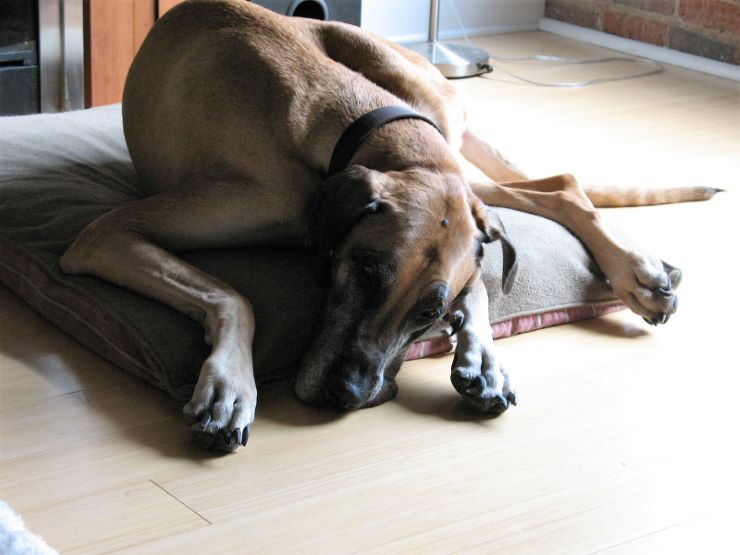It’s the look in the eyes that tell it all. Some dog owners say that they see the look of death in their friend’s eyes. This look, coupled with a swollen stomach, signals a horrible disease, referred to as gastric dilatation-volvulus (GDV), or simply as “Bloat in dogs”. It’s one of the most dangerous and misunderstood diseases that dogs can suffer from.
![]()

Photo Credit: iraxmas/Flickr CC
Technically, GDV (Bloat) is stomach bloating and gastric torsion in dogs. It begins with the accumulation of air in the stomach, or at least we think that comes first, though even that point is controversial. Some believe that air is produced as a byproduct of food digestion and this distends the stomach, allowing the bloated stomach to twist. The others theorize that the stomach twists first and air accumulates either from being swallowed or manufactured by the food in the stomach. Studies are inconclusive.
To add to the problem, the rotation (torsion) of the stomach pulls the spleen and pancreas along with it. Blood flow to these vital organs is disrupted, resulting in the production of hormones that affect the heart. They can literally stop the heart cold.
The Best Thing you can do? – Know the signs and get veterinary attention right away if you suspect bloat!
The initial GDV treatment depends on clinical signs of bloat in dogs and their severity.
When veterinarians see a dog with GDV, there is a predictable treatment plan. First, the doctor confirms the GDV diagnosis. In many cases, inserting a needle into the swollen belly and hearing air rush out is all that is needed. In others, a radiograph is taken to reveal an air-filled stomach. Coupled with the clinical signs of weakness, pale gums, and going into shock, the diagnosis is readily apparent.
The bloat treatment usually begins with the placement of an intravenous line to inject fluids and reverse the hypotension.
The next step is decompression of the distended stomach. One way to do this is to push a large-bore tube through the mouth, down the esophagus, and into the stomach. This cannot be done in some bloated dogs due to the twist at the stomach entrance.
If there is massive stomach enlargement or the dog is in such bad shape that it may go into cardiac arrest, a needle put through the skin into the bloated stomach can release some air. This may also make it easier to pass the stomach tube. Deflation of the stomach allows easier breathing, better blood circulation, and a possibility that the stomach flips back to its natural position on its own.
The next step is surgery to correct the dog’s stomach torsion. This should occur within one to two hours.
The surgery starts with a cut along the bottom of the belly. The bloated stomach pops out of the incision. It can then be examined to see which way it is rotated. Once it is pushed or pulled into the correct position, it can be further deflated and checked for damage. With a compromised blood supply, part of the stomach wall can die. This may need to be resected (surgically removed). The spleen is often removed because it also suffers damage.
The most critical time for GDV (Bloat) in dogs is directly after what is thought to be successful surgery. Some dogs appear to be doing well, yet suddenly succumb to cardiac arrest. Other complications include pancreatitis, abdominal infections, and rupture of the stomach. Aggressive fluid treatment, antibiotics, as well as monitoring with frequent blood tests can help reduce fatalities.
Current mortality rates for dogs with GVD are 10 to 15 percent. In the past, it was up to 45 percent. The difference is the intensive care and monitoring now available.
Bloat and torsion in dogs recur in 75 to 90 percent of patients. To prevent this, most veterinarians do a gastropexy – affix the stomach to the abdominal wall. This is considered a permanent solution, and though a dog may still bloat, it stops the stomach from twisting.
There has been great debate on what contributes to GDV in dogs. A helpful review of what causes bloat in dogs was recently compiled by Dr. Jennifer Ogeer, an associate professor in critical care at the Western College of Veterinary Medicine in Saskatoon.
The question is – what can we do to preclude GDV? Dr. Theresa Fossum, a veterinary surgeon, presented what she recommends for preventing bloat in dogs at an important veterinary conference.
Dr. Jeff Grognet is a veterinarian, and Mike Annan is a canine obedience instructor and behaviorist. Together they have created the ACE Academy for Canine Educators. They have produced a free course for shelter and rescue (though anyone can benefit from it) as well as a weekly newsletter that educates on canine (and feline) health, obedience, and behavior issues.
This article is guest-written by Dr. Jeff Grognet specially for the Russian Dog website.
We use cookies to offer you a better browsing experience, analyze site traffic, personalize content and ads.